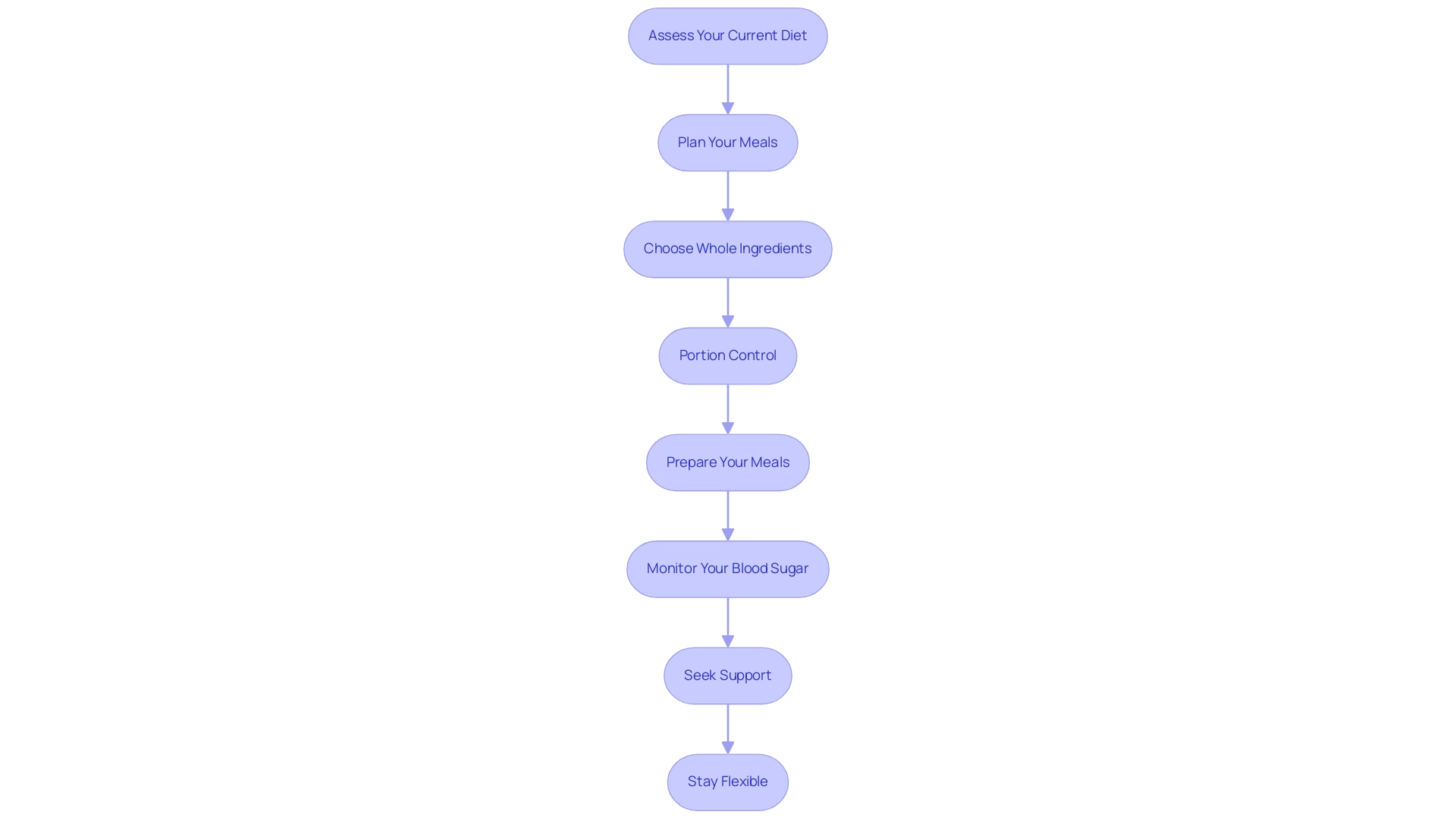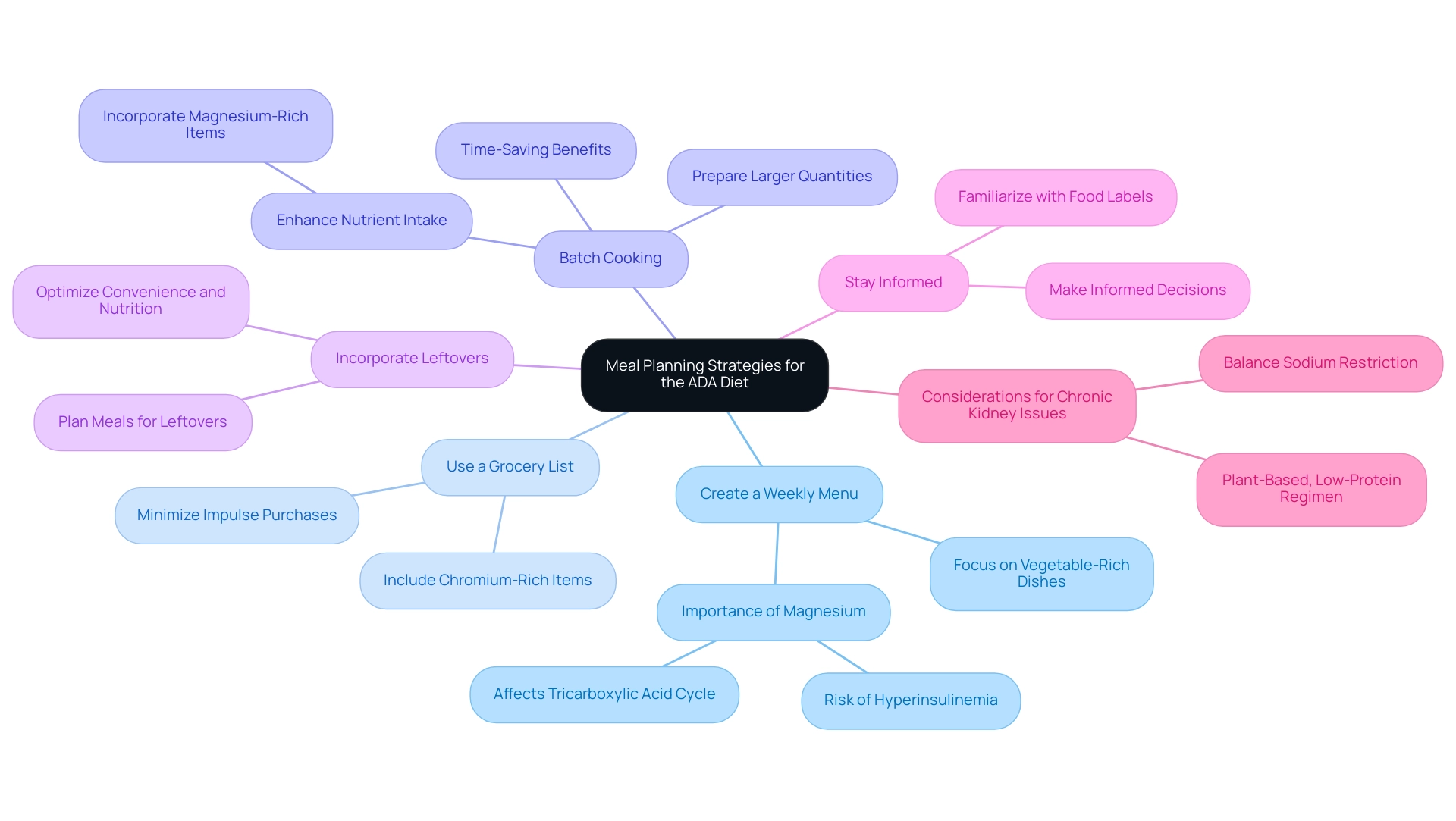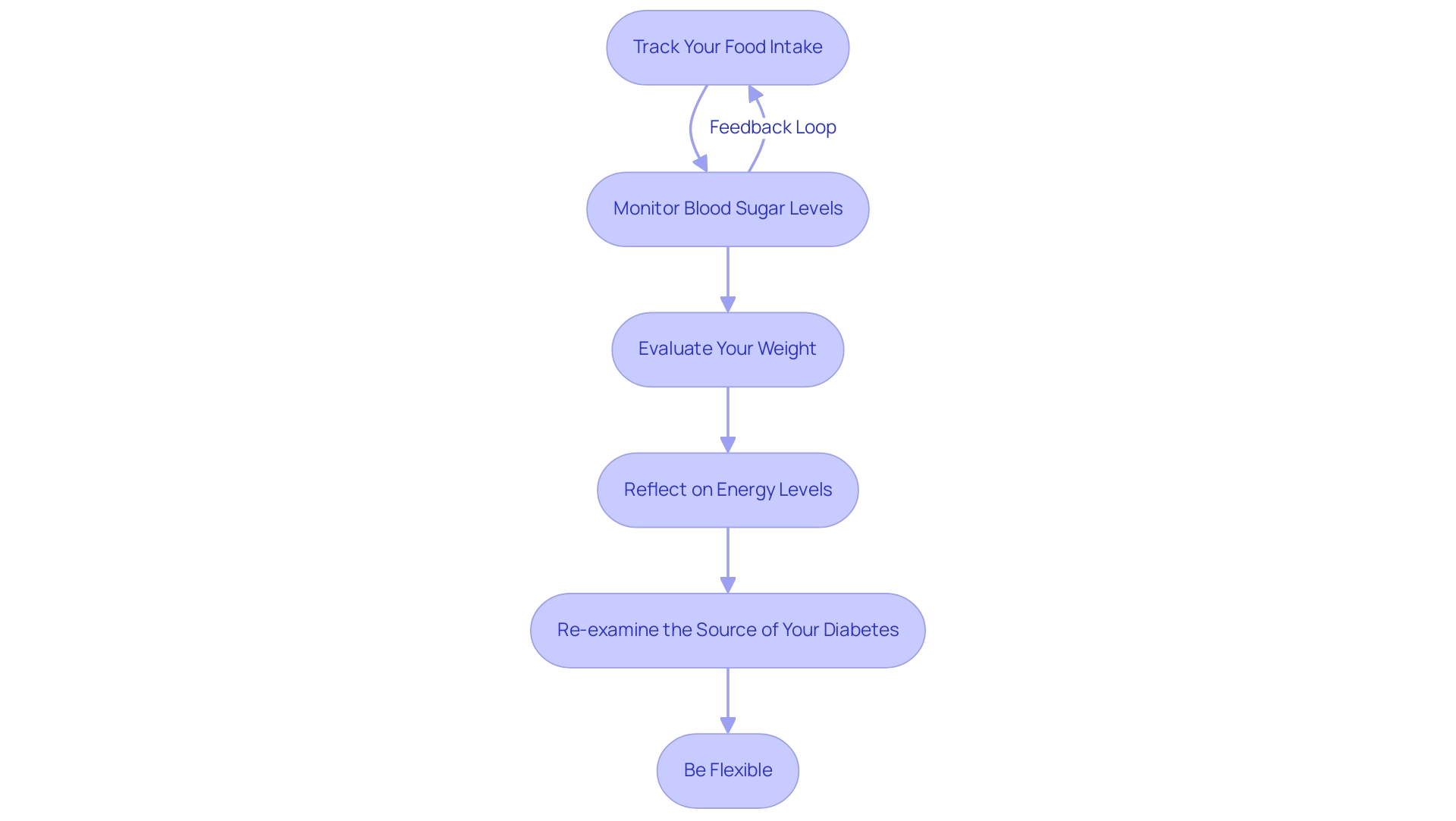Introduction
The American Diabetes Association (ADA) diet plan serves as a vital framework for individuals seeking to manage diabetes effectively through balanced nutrition and informed dietary choices. By focusing on principles such as:
- Carbohydrate counting
- Balanced meals
- Incorporation of fiber and healthy fats
this diet not only aids in blood sugar control but also empowers individuals to take charge of their health. As the prevalence of diabetes continues to rise, understanding and implementing the ADA diet becomes increasingly important.
This article outlines the key principles of the ADA diet, offers a step-by-step guide for its implementation, and provides strategies for meal planning and navigating social situations, ensuring that individuals can maintain their dietary commitments while enjoying a fulfilling lifestyle.
Understanding the ADA Diet Plan: Key Principles and Benefits
The ADA diet plan PDF aims to encourage balanced nutrition and efficient blood sugar control, empowering patients to reduce anxiety regarding complications through holistic care. By following these guidelines, individuals can feel more in control of their health, reducing fears related to the potential complications of this condition. Central to this approach are several key principles:
- Carbohydrate Counting: A fundamental aspect of diabetes management is understanding how carbohydrates affect blood sugar levels. The ADA promotes monitoring carbohydrate consumption to sustain stable glucose levels, which is essential for effective management of the condition.
- Balanced Meals: Each meal should encompass a combination of macronutrients—carbohydrates, proteins, and healthy fats—to ensure satiety and foster stable blood sugar levels throughout the day.
- Incorporating Fiber: Foods high in fiber, such as whole grains, fruits, and vegetables, are essential for regulating blood sugar levels and enhancing digestive health. Higher fiber consumption can result in improved glycemic regulation, which is essential for controlling blood sugar levels.
- Healthy Fats: Emphasis should be placed on unsaturated fats, commonly found in nuts, seeds, avocados, and olive oil, while limiting the intake of saturated and trans fats. This nutritional change promotes heart wellness and assists in general blood sugar control. According to a case study titled ‘Consumer Preferences for Sweeteners,’ consumers view naturally derived sweeteners like D-allulose favorably, which may affect their food choices towards healthier fats and lower-calorie options.
- Regular Meal Timing: Consistent meal timing is crucial for stabilizing blood sugar levels. By adhering to a regular eating schedule, individuals can prevent extreme fluctuations in their glucose levels.
The financial consequences of controlling blood sugar are considerable, with additional medical expenses per individual rising from $10,179 in 2012 to $12,022 in 2022. This highlights the significance of effective dietary practices in managing blood sugar levels. The benefits of following the ADA diet plan PDF go beyond nutritional balance, including improved blood sugar control, efficient weight regulation, and a reduced risk of complications related to blood sugar issues.
Such approaches resonate with the transformative experiences shared by patients at the Integrative Wellness Center, who have successfully reversed their condition through personalized care. One patient remarked, “If you have the opportunity to join this family, DO IT! It will be the most important choice you will ever make in your life.”
Following the ADA diet plan PDF principles not only facilitates better diabetes management but also promotes an overall healthier lifestyle. Recent studies have shown that adopting these nutritional principles can lead to improved health outcomes, confirming their effectiveness in blood sugar control.
Step-by-Step Guide to Implementing the ADA Diet Plan
To successfully implement the ADA diet plan, adhere to the following structured steps:
- Assess Your Current Diet: Begin by keeping a diary of your meals for at least one week. This practice is crucial for identifying your current eating habits and pinpointing areas that require modification. Research shows that maintaining a meal journal can improve nutritional changes by up to 50%, rendering it an effective tactic for managing Type 2 blood sugar issues.
- Plan Your Meals: Create a weekly meal plan that follows the ADA nutritional guidelines. It is essential to include a variety of items to ensure balanced nutrition, addressing the diverse dietary needs of individuals with diabetes.
- Choose Whole Ingredients: Prioritize whole, unprocessed items, including an array of fruits, vegetables, whole grains, lean proteins, and healthy fats. It is advisable to avoid sugary beverages and snacks laden with refined sugars, as these can negatively impact blood sugar levels.
- Portion Control: Implement portion control techniques by utilizing measuring cups and a scale. Getting acquainted with standard serving sizes can help prevent overeating, a common challenge for many individuals managing their health.
- Prepare Your Meals: Commit to cooking at home as frequently as possible. This approach allows you to control both the ingredients and portion sizes. Consider batch cooking to save time and ensure that you always have healthy options readily available.
- Monitor Your Blood Sugar: Regularly check your blood sugar levels to understand how different foods impact your body. This feedback is invaluable for making necessary adjustments to your meal plan.
- Seek Support: Connect with a registered dietitian or health coach specializing in managing blood sugar. Their expertise can offer tailored advice and assistance, which is essential for effective health oversight. As noted by Bargiota, A., “The effectiveness of a Nutrition Education Program for Patients with Type 2 Diabetes Mellitus hinges on continuous support and education.”
- Stay Flexible: Embrace the need for flexibility in your dietary approach. As you learn what works best for your body, be prepared to make adjustments to your meal plan. This adaptability is essential for long-term adherence to the ADA diet.
By following these structured steps, you can effectively implement the ADA diet plan, which will significantly improve your diabetes control. Additionally, consider the Mayo Clinic Diet, which employs a two-phase approach to weight control, providing structured guidance that promotes healthy eating habits.
Meal Planning Strategies for the ADA Diet
Implementing effective meal planning strategies can significantly enhance adherence to the ADA diet. Here are the four essential strategies to consider:
-
Create a Weekly Menu: Allocate a specific day each week dedicated to meal planning.
Ensure that your menu includes breakfast, lunch, dinner, and snacks, focusing on vegetable-rich dishes that support blood sugar regulation and overall health. This is particularly important as magnesium deficiency can adversely affect the tricarboxylic acid cycle, increasing the risk of hyperinsulinemia and insulin resistance.
-
Use a Grocery List: Develop a grocery list based on your weekly menu to minimize impulse purchases.
Following this list helps ensure that you obtain only those items that align with your dietary needs, supporting overall health and metabolic control. Incorporating chromium-rich items is also advantageous, as chromium plays a vital role in diabetes management and insulin sensitivity.
-
Batch Cooking: Preparing larger quantities of meals allows for portioning and storage for later use.
This method not only saves time but also ensures that healthy options are readily available for busy days. Incorporating vegetable-rich meals in your batch cooking can further enhance nutrient intake. Notably, recent studies suggest that magnesium supplementation can enhance insulin sensitivity, making it essential to incorporate magnesium-rich items in your batch cooking plans.
Verma and colleagues argue that large trials should be performed to validate the use of magnesium supplements to prevent and treat Type 2 diabetes.
-
Incorporate Leftovers: Intentionally plan meals that yield leftovers to save time and reduce waste.
For instance, roasting a large chicken can provide ingredients for salads or sandwiches the following day, optimizing both convenience and nutrition.
Additionally, Stay Informed: It is essential to familiarize yourself with food labels and nutritional information.
This knowledge enables you to make informed decisions while grocery shopping or eating out, directly affecting your nutritional adherence and overall health.
Moreover, for Type 2 individuals with chronic kidney issues, meal planning becomes more intricate. A predominantly plant-based, low-protein regimen is suggested to improve outcomes, while sodium restriction should be balanced to avoid hyponatremia, which can affect insulin sensitivity. By incorporating these strategies into your routine, including intelligent snacking choices, you can simplify meal preparation and sustain consistency with the ADA diet plan PDF, ultimately promoting better control of Type 2.
For more resources and tips, click to register.
Navigating Social Situations on the ADA Diet
Navigating social situations while adhering to the ADA diet can be challenging, yet with thoughtful preparation, success is attainable. Here are key strategies to facilitate this process:
- Communicate Your Needs: Proactively inform friends and family about your dietary preferences prior to gatherings. Effective communication can foster understanding and enable hosts to make necessary accommodations for your meal choices. Research suggests that clear communication about nutritional requirements significantly boosts adherence to eating plans, with one study demonstrating a direct link between effective communication and better results in managing blood sugar levels. As mentioned by Battelino et al., “effective nutritional communication is crucial for managing diabetes successfully.”
- Choose Wisely: Prior to dining out, take the time to review the restaurant’s menu. Identify healthier options or consider requesting modifications to align with your nutritional requirements, such as opting for a side salad instead of fries. This approach not only supports your health goals but also sets a precedent for your dining companions. Remember, insufficient intake of nuts and seeds has been linked to a 1.1% rise in the estimated incidence of Type 2 Diabetes, emphasizing the significance of making informed food choices.
- Bring Your Own Dish: When attending a potluck or social gathering, consider preparing and bringing a healthy dish that you enjoy. This guarantees you possess at least one meal choice that complies with your nutritional guidelines while also enabling you to share delightful dishes with others.
- Practice Portion Control: At social events, be mindful of portion sizes. Using smaller plates can help manage the amount you serve yourself. Aim to fill your plate with a variety of options, which not only adds balance to your meal but also promotes moderation in your servings. Personalized strategies, as emphasized in the case study on overbasalization awareness in insulin therapy, are crucial for effective nutritional management.
- Stay Mindful: Cultivate awareness of your eating habits in social settings. Take your time to savor your food, and listen to your body’s hunger cues to prevent overeating. Mindfulness in eating has been linked to better dietary choices and improved satisfaction with meals.
Implementing these strategies allows for enjoyment of social gatherings while remaining committed to your ADA diet plan. By prioritizing communication and preparation, individuals with this condition can navigate dining experiences with confidence.
Monitoring Progress and Making Adjustments
To ensure the effectiveness of the ADA diet plan PDF, it is essential to regularly monitor progress and be open to necessary adjustments, reflecting a holistic approach to managing Type 2 diabetes. This approach not only assists in managing eating habits but also aims to alleviate the anxiety that accompanies the worry surrounding potential complications of your disease:
- Track Your Food Intake: Utilizing a food diary or mobile application to log meals and snacks can be beneficial in identifying eating patterns and potential areas for improvement. Self-reported nutritional information may sometimes contain inaccuracies; hence, this practice can help clarify actual consumption.
- Monitor Blood Sugar Levels: Consistently checking blood glucose levels enables individuals to assess how their food choices impact their readings. Consistent blood sugar tracking is essential for making informed nutrition choices and enhancing management of blood sugar levels.
- Evaluate Your Weight: Monitoring weight and body measurements is essential, as significant changes can suggest whether the current nutritional approach is effective. In 2022, the total economic costs of diagnosed diabetes in the United States reached approximately $413 billion, highlighting the need for effective oversight strategies. This rising financial burden emphasizes the importance of adhering to the ADA diet plan PDF.
- Reflect on Energy Levels: Paying attention to daily energy levels and overall mood can serve as indicators of nutritional success. Increased energy and improved mood are often associated with effective dietary management and can empower patients to take charge of their health.
- Re-examine the Source of Your Diabetes: Understanding the root causes of your condition is crucial. By addressing these underlying issues, you can better manage your condition and reduce associated anxiety.
- Be Flexible: If certain items or habits are found to negatively affect blood sugar levels, it is important to be willing to modify the diet accordingly. Consulting with a dietitian or health coach can offer personalized guidance suited to individual needs, challenging common misconceptions about the condition and fostering a deeper understanding of insulin resistance.
By actively monitoring progress and being adaptable, individuals can enhance adherence to the ADA diet plan PDF, ultimately improving control of the condition. As Ronli Levi noted, ‘Finally, we outline the research, policy, and practice opportunities that exist to address food insecurity and reduce diabetes-related health disparities.’ This underscores the wider consequences of effective nutritional management in the context of blood sugar regulation.
Moreover, it’s important to recognize that the incidence rate of diagnosed diabetes among Asian, non-Hispanic adults stands at 3.8 per 1,000, underscoring the need for targeted dietary strategies in diverse populations.
Conclusion
Adopting the American Diabetes Association (ADA) diet plan is a proactive step towards effective diabetes management. By understanding and implementing key principles such as:
- Carbohydrate counting
- Balanced meals
- The integration of fiber and healthy fats
Individuals can significantly improve their blood sugar control and overall health. Regular meal timing and consistent monitoring of food intake further enhance this approach, ensuring that individuals remain in charge of their dietary choices.
Implementing the ADA diet requires a structured plan that includes:
- Meal preparation
- Portion control
- Flexible strategies for navigating social situations
By creating a weekly menu, utilizing a grocery list, and preparing meals in advance, individuals can streamline their dietary commitments while enjoying a variety of foods. Communication with family and friends about dietary needs also plays a crucial role in maintaining adherence to the diet during social gatherings.
Monitoring progress and being open to adjustments are essential components of successful diabetes management. Regularly tracking food intake, blood sugar levels, and personal energy levels allows for informed decisions that can lead to better health outcomes. As the understanding of diabetes evolves, so does the importance of adhering to a diet that not only manages blood sugar but also supports a healthier lifestyle.
In conclusion, the ADA diet plan offers a comprehensive framework for individuals managing diabetes. By embracing its principles and strategies, individuals can enhance their quality of life, reduce anxiety related to diabetes complications, and foster a sense of empowerment in their health journey. Prioritizing balanced nutrition and informed choices is vital for achieving lasting health benefits and improving overall well-being.
Frequently Asked Questions
What is the purpose of the ADA diet plan PDF?
The ADA diet plan PDF aims to encourage balanced nutrition and efficient blood sugar control, empowering patients to reduce anxiety regarding complications through holistic care.
What are the key principles of the ADA diet plan?
The key principles include carbohydrate counting, balanced meals with macronutrients, incorporating fiber, emphasizing healthy fats, and maintaining regular meal timing.
Why is carbohydrate counting important in diabetes management?
Carbohydrate counting helps individuals understand how carbohydrates affect blood sugar levels, which is essential for sustaining stable glucose levels.
How should meals be balanced according to the ADA diet plan?
Each meal should include a combination of carbohydrates, proteins, and healthy fats to ensure satiety and stable blood sugar levels throughout the day.
What role does fiber play in the ADA diet?
Foods high in fiber, such as whole grains, fruits, and vegetables, help regulate blood sugar levels and enhance digestive health.
What types of fats are recommended in the ADA diet?
The ADA diet emphasizes unsaturated fats found in nuts, seeds, avocados, and olive oil while recommending the limitation of saturated and trans fats.
How does regular meal timing affect blood sugar levels?
Consistent meal timing is crucial for stabilizing blood sugar levels and preventing extreme fluctuations in glucose.
What are the financial implications of managing blood sugar effectively?
The financial consequences of controlling blood sugar are significant, with individual medical expenses rising from $10,179 in 2012 to $12,022 in 2022.
What steps should be taken to implement the ADA diet plan successfully?
Steps include assessing your current diet, planning meals, choosing whole ingredients, practicing portion control, preparing meals at home, monitoring blood sugar, seeking support, and staying flexible.
Why is meal journaling beneficial for individuals with diabetes?
Keeping a meal diary helps identify current eating habits and areas for modification, improving nutritional changes by up to 50%.
How can individuals ensure they are choosing healthy ingredients?
Prioritize whole, unprocessed items like fruits, vegetables, whole grains, lean proteins, and healthy fats, while avoiding sugary beverages and snacks with refined sugars.
What is the importance of monitoring blood sugar levels?
Regularly checking blood sugar levels helps individuals understand how different foods impact their body, allowing for necessary adjustments to their meal plan.
How can individuals find support while following the ADA diet plan?
Connecting with a registered dietitian or health coach specializing in managing blood sugar can provide tailored advice and assistance for effective health oversight.
Why is flexibility important in the ADA diet plan?
Embracing flexibility allows individuals to adapt their dietary approach based on what works best for their body, which is essential for long-term adherence to the diet.



